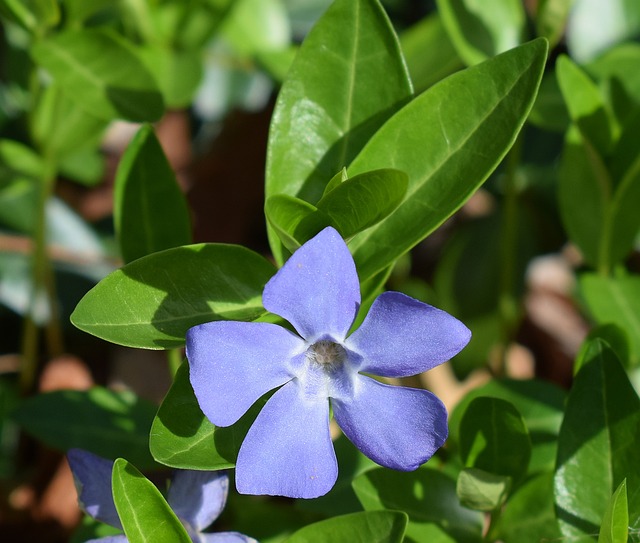Understanding the Charm of Periwinkle- A Gardener’s Guide to Vinca
Introduction
Welcome to our gardening blog, where today we delve into the world of periwinkle, a plant that has captured the hearts of gardeners worldwide. Known scientifically as Vinca, periwinkle is not just a pretty face; it’s a versatile and robust plant that adds color and life to any garden. In this comprehensive guide, we’ll explore the various aspects of periwinkle, from its botanical background to its care, ensuring you have all the information needed to integrate this wonderful plant into your garden.
Botanical Overview
Common Names: Periwinkle, Vinca, Myrtle
Scientific Name: Vinca minor (Common Periwinkle), Vinca major (Greater Periwinkle)
Family: Apocynaceae
Periwinkle is a perennial evergreen known for its glossy, oval leaves and charming, five-petaled flowers that typically bloom in hues of blue, white, or purple. Originating in Europe, this plant has become popular worldwide due to its hardiness and low-maintenance nature.
Vinca minor and Vinca major can be grown in a wide range of USDA hardiness zones. Generally, Vinca minor is hardy in zones 4 through 9, making it suitable for many climates, including colder regions. On the other hand, Vinca major is more suited to warmer climates and is typically hardy in zones 7 through 9.
These zones indicate the plant’s tolerance to different climatic conditions:
- Zone 4: Cold winter climates with minimum temperatures ranging from -30 to -20 degrees Fahrenheit.
- Zones 5 to 9: Gradually warmer climates with zone 9 experiencing mild winters.
It’s important to note that while periwinkle is adaptable to many environments, its growth habit and health can vary significantly depending on the specific conditions of each zone. In colder zones, it may grow more slowly or require protection during extreme winter conditions, whereas in warmer zones, it might spread more aggressively.
Varieties of Periwinkle
- Vinca minor (Common Periwinkle)– Known for its smaller stature and flowers, it’s ideal for ground cover and shaded areas.
- Vinca major (Greater Periwinkle)– Larger in both leaf size and flower, it’s perfect for creating a lush, green backdrop in gardens.
Periwinkle (Vinca) is a versatile plant with several different color varieties, each offering unique characteristics in terms of leaf patterns, flowers, and growth habits. Here are some notable varieties and their distinct colors:
- Vinca minor ‘Alba’: This variety features pure white flowers, providing a crisp contrast against its dark green leaves.
- Vinca minor ‘Atropurpurea’: Known for its rich, deep purple flowers, this variety adds a bold splash of color to the garden.
- Vinca minor ‘Illumination’: Distinguished by its golden-yellow variegated leaves, it has blue flowers that create a stunning visual impact.
- Vinca minor ‘Ralph Shugert’: This type sports variegated leaves with a white border and vibrant blue flowers.
- Vinca major ‘Variegata’: It’s popular for its large, variegated leaves with creamy white edges and pale blue flowers.
- Vinca major ‘Wojo’s Jem’: Features green leaves with yellow centers and large lavender-blue flowers.
- Vinca minor ‘Bowles’ Variety’: Known for its larger leaf size and abundant lavender-blue flowers, it’s a favorite among gardeners for ground cover.
- Vinca minor ‘Gertrude Jekyll’: This variety is admired for its white flowers, providing a softer look in the garden.
Each variety offers a unique aesthetic appeal, making it a versatile choice for different garden themes and color schemes.
Planting and Growth Conditions
- Sunlight– Periwinkle thrives in partial to full shade, making it a perfect choice for those tricky low-light areas in your garden.
- Soil– It’s adaptable to most soil types but prefers well-drained soil.
- Planting– Spring or early fall is ideal for planting periwinkle to allow the roots to establish before extreme weather conditions.
Care and Maintenance
- Watering– While drought-tolerant, regular watering helps periwinkle flourish, especially in dry conditions.
- Fertilizing– A balanced, all-purpose fertilizer applied in spring can enhance growth.
- Pruning– Regular pruning isn’t necessary, but cutting back overgrown areas in early spring can promote a more lush growth.
Benefits and Uses
Periwinkle isn’t just aesthetically pleasing; it serves practical purposes in the garden:
- Erosion Control– Its dense growth habit makes it excellent for controlling soil erosion.
- Ground Cover– Periwinkle is a popular choice for ground cover due to its ability to spread and cover large areas.
- Low Maintenance– Its ability to thrive in challenging conditions makes it a boon for busy gardeners.
Potential Problems
While generally robust, periwinkle can face issues such as:
- Pests and Diseases– Watch out for vinca wilt, a fungal disease, and keep an eye on common pests like aphids.
- Invasive Nature– In some regions, periwinkle can become invasive. Always check with local guidelines before planting.
Conclusion
Periwinkle, with its beautiful blooms and resilient nature, is a fantastic addition to any garden. Whether you’re a seasoned gardener or a beginner, this plant offers beauty with minimal fuss. Embrace the charm of Vinca in your garden and enjoy the splash of color and greenery it brings.
Remember, periwinkle’s beauty lies in its simplicity and adaptability, making it a must-have in any gardener’s repertoire. Happy gardening!
Frequently Asked Questions About Periwinkle
- What is Periwinkle? Periwinkle, also known as Vinca, is a versatile and attractive perennial plant. It is well-known for its glossy green leaves and star-shaped, usually blue or purple flowers.
- What are the Common Types of Periwinkle? The two most common types are Vinca minor (common periwinkle) and Vinca major (greater periwinkle). Vinca minor is more compact, while Vinca major has larger leaves and flowers.
- How Do I Plant Periwinkle? Plant periwinkle in well-drained soil and a partially shaded area. It can adapt to a wide range of soil types and light conditions, but thrives best in moderate environments.
- When is the Best Time to Plant Periwinkle? The ideal time to plant periwinkle is during the spring or fall when the weather is cooler.
- How Much Sun Does Periwinkle Need? Periwinkle prefers partial shade but can tolerate full sun in cooler climates. Too much sun can scorch the leaves, especially in hotter regions.
- Is Periwinkle Invasive? Periwinkle can be aggressive in its growth and spread, particularly in favorable conditions. It’s important to manage its growth to prevent it from overtaking other plants.
- How Do I Control the Spread of Periwinkle? Regular pruning and removing unwanted runners can help control its spread. Consider planting it in contained areas or using barriers.
- Can Periwinkle Grow in Containers? Yes, periwinkle can grow in containers, making it a versatile choice for patios and balconies.
- What are the Benefits of Planting Periwinkle? Periwinkle is excellent for ground cover, erosion control, and adding color to shaded areas. It’s also low-maintenance and drought-resistant.
- Does Periwinkle Have Any Medicinal Properties? Historically, periwinkle has been used in traditional medicine. It contains alkaloids, which have been the subject of various health-related studies.
- How Often Should I Water Periwinkle? Young plants need regular watering to establish. Mature plants are drought-tolerant and require minimal watering.
- Are There Any Pests or Diseases I Should Worry About? Periwinkle is relatively pest-free, but it can be susceptible to root rot in overly wet conditions. Good drainage and proper spacing can help prevent this.
- How Do I Propagate Periwinkle? Propagation can be easily done through stem cuttings or by dividing the plants in early spring or fall.
- Is Periwinkle Deer-Resistant? Periwinkle is generally deer-resistant, making it a good choice in areas where deer are a common problem.
- Can Periwinkle Be Used in Companion Planting? Yes, periwinkle pairs well with other shade-loving plants like ferns and hostas. Its dense growth can also help suppress weeds.
Recent Posts

The Power of Mounding: An Essential Gardening Technique for Healthy Plants

The Ultimate Guide to Philodendron Birkin – Care, Tips, and Benefits

Watering Plants – Indoor Edition

The Advantages of Built-Up Garden Beds: A Gardener’s Best Friend

The Secret Weapon for Lush Blooms: How to Create the Perfect Fertilizer Schedule












You must be logged in to post a comment.